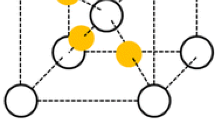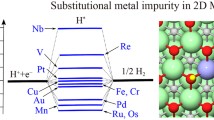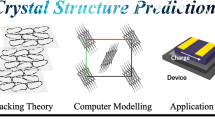Abstract
(R)-3-methylcyclohexanone (R-3MCHO) has been shown to adsorb enantiospecifically on naturally chiral Cu surfaces vicinal to the Cu(110) plane. Adsorption of R-3MCHO on seven Cu single crystal surfaces vicinal to (110) was studied using temperature programmed desorption. These surfaces include Cu(110), Cu(771), Cu(430), Cu(13,9,1)R&S and Cu(651)R&S. The Cu(13,9,1)R&S and Cu(651)R&S surfaces are naturally chiral surfaces with terrace-step-kink structures. Enantioselective adsorption of R-3MCHO takes place on the chiral kink sites of these surfaces. Three R-3MCHO desorption features were resolved in the TPD spectra on Cu(13,9,1)R&S and Cu(651)R&S surfaces. Based upon comparisons between these and other Cu single crystal surfaces, they were assigned to desorption of R-3MCHO from flat terrace, close-packed step and kink sites. The desorption of R-3MCHO from the row and trough structure of the Cu(110) surface resembled desorption from a step structure rather than from a flat Cu(111) terrace. R-3MCHO desorbs enantiospecifically from the Cu(13,9,1)R&S and Cu(651)R&S surfaces. The peaks associated with R-3MCHO desorbing from the R- and S-chiral kink sites on Cu(13,9,1)R&S differed in temperature by 2.4 ± 0.8 K. This corresponds to an enantiospecific difference in the desorption energies of 0.7 ± 0.2 kJ/mol, with a preference for R-3MCHO adsorption at the R-kinks. In contrast, R-3MCHO has a desorption energy from the S-kinks on the Cu(651)S surface that is 0.7 ± 0.2 kJ/mol higher than from the R-kinks on the Cu(651)R surface.







Similar content being viewed by others
References
Polastro E (1995) Commercial outlook for chirality. Quo vadis? In: Jannes G, Dubois V (eds) Chiral reactions in heterogeneous catalysis. Plenum Publications, New York, p 5
Stinson SC (2001) Chiral pharmaceuticals. Chem Eng News 78:55–79
Stinson SC (2000) Chiral drugs. Chem Eng News 78(43):55–78
Zaera F (2008) Chiral modification of solid surfaces: a molecular view. J Phys Chem C 112(42):16196–16203
Baiker A (1997) Progress in asymmetric heterogeneous catalysis: design of novel chirally modified platinum metal catalysts. J Mol Catal A 115(3):473–493
Izumi Y (1983) Modified Raney-nickel (Mrni) catalyst—heterogeneous enantio-differentiating (asymmetric) catalyst. Adv Catal 32:215–271
Mallat T, Orglmeister E, Baiker A (2007) Asymmetric catalysis at chiral metal surfaces. Chem Rev 107(11):4863–4890
McFadden CF, Cremer PS, Gellman AJ (1996) Adsorption of chiral alcohols on “chiral” metal surfaces. Langmuir 12(10):2483–2487
Sholl DS, Asthagiri A, Power TD (2001) Naturally chiral metal surfaces as enantiospecific adsorbents. J Phys Chem B 105(21):4771–4782
van Hove MA, Somorjai GA (1980) New microfacet notation for high-miller-index surfaces of cubic materials with terrace, step and kink structures. Surf Sci 92(2–3):489–518
Horvath J, Kamakoti P, Koritnik A, Sholl DS, Gellman AJ (2004) Enantioselective separation on a naturally chiral surface. J Am Chem Soc 126(45):14988–14994
Horvath JD, Baker L, Gellman AJ (2008) Enantiospecific orientation of R-3-methylcyclohexanone on the chiral Cu(643)(R/S) surfaces. J Phys Chem C 112(20):7637–7643
Horvath JD, Gellman AJ (2002) Enantiospecific desorption of chiral compounds from chiral Cu(643) and achiral Cu(111) surfaces. J Am Chem Soc 124(10):2384–2392
Horvath JD, Gellman AJ (2003) Naturally chiral surfaces. Top Catal 25(1–4):9–15
Ahmadi A, Attard G, Feliu J, Rodes A (1999) Surface reactivity at “chiral” platinum surfaces. Langmuir 15(7):2420–2424
Attard GA, Ahmadi A, Jenkins DJ, Hazzazi OA, Wells PB, Griffin KG, Johnston P, Gillies JE (2003) The characterisation of supported platinum nanoparticles on carbon used for enantioselective hydrogenation: a combined electrochemical—STM approach. ChemPhysChem 4(2):123–130
Attard GA, Harris C, Herrero E, Feliu J (2002) The influence of anions and kink structure on the enantioselective electro-oxidation of glucose. Faraday Discuss 121:253–266
Bhatia B, Sholl DS (2005) Enantiospecific chemisorption of small molecules on intrinsically chiral Cu surfaces. Angew Chem Int Ed 44(47):7761–7764
Gellman AJ, Horvath JD, Buelow MT (2001) Chiral single crystal surface chemistry. J Mol Catal A 167(1–2):3–11
Greber T, Sljivancanin Z, Schillinger R, Wider J, Hammer B (2006) Chiral recognition of organic molecules by atomic kinks on surfaces. Phys Rev Lett 96(5):056103
Horvath J, Kamakoti P, Koritnik A, Sholl DS, Gellman AJ (2004) Enantioselective separation on a naturally chiral surface. J Am Chem Soc 126(45):14988–14994
Horvath JD, Gellman AJ (2001) Enantiospecific desorption of R- and S-propylene oxide from a chiral Cu(643) surface. J Am Chem Soc 123(32):7953–7954
Horvath JD, Gellman AJ, Sholl DS, Power TD (2000) Enantiospecific properties of chiral single crystal surfaces. In: Hicks JM (ed) Chirality: physical chemistry, San Francisco, 2002. ACS Publications, San Francisco, pp 269–282
Huang Y, Gellman AJ (2008) Enantiospecific adsorption of (R)-3-methylcyclohexanone on naturally chiral Cu(531)(R&S) surfaces. Catal Lett 125(3–4):177–182
Power TD, Sholl DS (1999) Enantiospecific adsorption of chiral hydrocarbons on naturally chiral Pt and Cu surfaces. J Vac Sci Technol A 17(4):1700–1704
Rampulla DM, Francis AJ, Knight KS, Gellman AJ (2006) Enantioselective surface chemistry of R-2-bromobutane on Cu(643)(R&S) and Cu(531)(R&S). J Phys Chem B 110(21):10411–10420
Schunack M, Laegsgaard E, Stensgaard I, Johannsen I, Besenbacher F (2001) A chiral metal surface. Angew Chem Int Ed 40(14):2623–2626
Sholl DS (1998) Adsorption of chiral hydrocarbons on chiral platinum surfaces. Langmuir 14(4):862–867
Sholl DS, Gellman AJ (2009) Developing chiral surfaces for enantioselective chemical processing. AIChE J 55(10):2484–2490
Sljivancanin Z, Gothelf KV, Hammer B (2002) Density functional theory study of enantiospecific adsorption at chiral surfaces. J Am Chem Soc 124(49):14789–14794
Zhao XY, Perry SS (2004) Ordered adsorption of ketones on Cu(643) revealed by scanning tunneling microscopy. J Mol Catal A 216(2):257–262
Attard GA (2001) Electrochemical studies of enantioselectivity at chiral metal surfaces. J Phys Chem B 105(16):3158–3167
Jenkins SJ, Pratt SJ (2007) Beyond the surface atlas: a roadmap and gazetteer for surface symmetry and structure. Surf Sci Rep 62(10):373–429
Zhao XY, Perry SS, Horvath JD, Gellman AJ (2004) Adsorbate induced kink formation in straight step edges on Cu(533) and Cu(221). Surf Sci 563(1–3):217–224
Somorjai GA, Li Y (2010) Introduction to surface chemistry and catalysis, 2nd edn. Wiley, New York
Baber AE, Gellman AJ, Sholl DS, Sykes ECH (2008) The real structure of naturally chiral Cu{643}. J Phys Chem C 112(30):11086–11089
Baker L, Holsclaw B, Baber AE, Tierney HL, Sykes ECH, Gellman AJ (2010) Adsorption site distributions on Cu(111), Cu(221), and Cu(643) as determined by Xe adsorption. J Phys Chem C 114(43):18566–18575
Clegg ML, Driver SM, Blanco-Rey M, King DA (2010) Atomic roughness of an intrinsically chiral surface orientation of an fcc metal: Cu{531}. J Phys Chem C 114(9):4114–4117
Redhead PA (1962) Thermal desorption of gases. Vacuum 12:203–211
Acknowledgment
The authors would like to acknowledge support from the US DOE through grant number DE-FG02-03ER15472.
Author information
Authors and Affiliations
Corresponding author
Rights and permissions
About this article
Cite this article
Huang, Y., Gellman, A.J. Enantiospecific Adsorption of (R)-3-Methylcyclohexanone on Naturally Chiral Surfaces Vicinal to Cu(110). Top Catal 54, 1403–1413 (2011). https://doi.org/10.1007/s11244-011-9756-0
Published:
Issue Date:
DOI: https://doi.org/10.1007/s11244-011-9756-0




